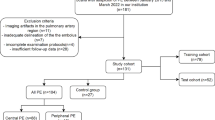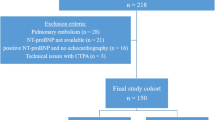Abstract
This preliminary study investigated the feasibility of a combined model constructed using radiomic features based on computed tomography (CT) and clinical features to predict adverse clinical outcomes in acute pulmonary embolism (APE). Currently, there is no widely recognized predictive model. Patients with confirmed APE who underwent CT pulmonary angiography were retrospectively categorized into good and poor prognosis groups. Seventy-four patients were randomized into a training (n = 51) or validation (n = 23) cohort. Feature extraction was performed using 3D-Slicer software. The least absolute shrinkage and selection operator regression was used to identify the optimal radiomics features and calculate the radiomics scores; subsequently, the radiomics model was developed. A combined predictive model was constructed based on radiomics scores and selected clinical features. The predictive efficacy of the three models (radiomics, clinical and combined) was assessed by plotting receiver operating characteristic curves. Furthermore, the calibration curves were graphed and the decision curve analysis was performed. Four radiomic features were screened to calculate the radiomic score. Right ventricular to left ventricular ratio (RV/LV) ≥ 1.0 and radiomics score were independent risk factors for adverse clinical outcomes. In the training and validation cohorts, the areas under the curve (AUCs) for the RV/LV ≥ 1.0 (clinical) and radiomics score prediction models were 0.778 and 0.833 and 0.907 and 0.817, respectively. The AUCs for the combined model of RV/LV ≥ 1.0 and radiomics score were 0.925 and 0.917, respectively. The combined and radiomics models had high clinical assessment efficacy for predicting adverse clinical outcomes in APE, demonstrating the clinical utility of both models. Calibration curves exhibited a strong level of consistency between the predictive and observed probabilities of poor and good prognoses in the combined model. The combined model of RV/LV ≥ 1.0 and radiomics score based on CT could accurately and non-invasively predict adverse clinical outcomes in patients with APE.







Similar content being viewed by others
Data availability
The datasets used and/or analyzed in the current study are available from the corresponding author upon reasonable request.
References
Kaptein FHJ, Kroft LJM, Hammerschlag G et al (2021) Pulmonary infarction in acute pulmonary embolism. Thromb Res 202:162–169
Konstantinides SV, Torbicki A, Agnelli G et al (2014) 2014 ESC guidelines on the diagnosis and management of acute pulmonary embolism. Eur Heart J 35(43):3069a–3069k
Remy-Jardin M, Pistolesi M, Goodman LR et al (2007) Management of suspected acute pulmonary embolism in the era of CT angiography: a statement from the Fleischner society. Radiology 245:315–329
Konstantinides SV, Meyer G, Becattini C et al (2019) 2019 ESC guidelines for the diagnosis and management of acute pulmonary embolism developed in collaboration with the European Respiratory Society (ERS): the task force for the diagnosis and management of acute pulmonary embolism of the European Society of Cardiology (ESC). Eur Respir J 54(3):1901647
Lambin P, Rios-Velazquez E, Leijenaar R et al (2012) Radiomics: extracting more information from medical images using advanced feature analysis. Eur J Cancer 48(4):441–446
Lambin P, Leijenaar RTH, Deist TM et al (2017) Radiomics: the bridge between medical imaging and personalized medicine. Nat Rev Clin Oncol 14(12):749–762
Limkin EJ, Sun R, Dercle L et al (2017) Promises and challenges for the implementation of computational medical imaging (radiomics) in oncology. Ann Oncol 28(6):1191–1206
Patel TR, Santo BA, Baig AA et al (2023) Histologically interpretable clot radiomic features predict treatment outcomes of mechanical thrombectomy for ischemic stroke. Neuroradiology 65(4):737–749
Yusuying S, Lu Y, Zhang S et al (2023) CT-based thrombus radiomics nomogram for predicting secondary embolization during mechanical thrombectomy for large vessel occlusion. Front Neurol 14:1152730
Kolossváry M, De Cecco CN, Feuchtner G et al (2019) Advanced atherosclerosis imaging by CT: radiomics, machine learning and deep learning. J Cardiovasc Comput Tomogr 13(5):274–280
Qiu W, Kuang H, Nair J et al (2019) Radiomics-based intracranial thrombus features on CT and CTA predict recanalization with intravenous alteplase in patients with acute ischemic stroke. Am J Neuroradiol 40(1):39–44
Surov A, Akritidou M, Bach AG et al (2021) A new index for the prediction of 30-day mortality in patients with pulmonary embolism: the pulmonary embolism mortality score (PEMS). Angiology 72(8):787–793
Schmid J, Nagy E, Kaufmann-Bühler AK et al (2022) Diagnosing pulmonary embolism with computed tomography pulmonary angiography: diagnostic accuracy of a reduced scan range. J Thorac Imaging 37(5):323–330
Schoepf UJ, Kucher N, Kipfmueller F et al (2004) Right ventricular enlargement on chest computed tomography: a predictor of early death in acute pulmonary embolism. Circulation 110(20):3276–3280
Rizzo S, Botta F, Raimondi S et al (2018) Radiomics: the facts and the challenges of image analysis. Eur Radiol Exp 2(1):36
Koçak B, Durmaz EŞ, Ateş E et al (2019) Radiomics with artificial intelligence: a practical guide for beginners. Diagn Interv Radiol 25:485–495
Image IBSI (2022) The image biomarker standardisation initiative (third chapter): image features. https://ibsi.readthedocs.io/en/latest/03_image_features.html
Meinel FG, Nance JW Jr, Schoepf UJ et al (2015) Predictive value of computed tomography in acute pulmonary embolism: systematic review and meta-analysis. Am J Med 128(7):747-759.e2
Sarioglu O, Sarioglu FC, Capar AE et al (2022) Clot-based radiomics features predict first pass effect in acute ischemic stroke. Interv Neuroradiol 28(2):160–168
Ende-Verhaar YM, Kroft LJM, Mos ICM et al (2017) Accuracy and reproducibility of CT right-to-left ventricular diameter measurement in patients with acute pulmonary embolism. PLoS ONE 12(11):e0188862
Doğan H, de Roos A, Geleijins J et al (2015) The role of computed tomography in the diagnosis of acute and chronic pulmonary embolism. Diagn Interv Radiol 21(4):307–316
Jiménez D, Lobo JL, Monreal M et al (2014) Prognostic significance of multidetector CT in normotensive patients with pulmonary embolism: results of the protect study. Thorax 69(2):109–115
Xiaoming Z, Gang H (2018) A radiomics nomogram based on CT pulmonary angiographic data for predicting adverse outcomes in non-high-risk acute pulmonary embolism patients. Eur Respir J 52:OA3596
Kumar V, Gu Y, Basu S et al (2012) Radiomics: the process and the challenges. Magn Reson Imaging 30(9):1234–1248
Acknowledgements
Not applicable.
Funding
This study was supported by a grant from the Science and Technology Project of the Hebei Provincial Science and Technology Department (21377769D).
Author information
Authors and Affiliations
Contributions
(I) Conception and design: YF and WDW; (II) administrative support: WDW; (III) provision of study materials or patients: JMM and PZY; (IV) collection and assembly of data: CR and YY; (V) data analysis and interpretation: SYY and YZX; (VI) manuscript writing: all authors; (VII) final approval of the manuscript: all authors.
Corresponding author
Ethics declarations
Competing interests
The authors declare no conflict of interest.
Ethical approval
This study involving human participants was reviewed and approved by the Institutional Review Board of First Affiliated Hospital of Hebei North University.
Informed consent
Written informed consent for participation was not required for this study in accordance with national legislation and institutional requirements.
Consent for publication
Not applicable.
Additional information
Publisher's Note
Springer Nature remains neutral with regard to jurisdictional claims in published maps and institutional affiliations.
Rights and permissions
Springer Nature or its licensor (e.g. a society or other partner) holds exclusive rights to this article under a publishing agreement with the author(s) or other rightsholder(s); author self-archiving of the accepted manuscript version of this article is solely governed by the terms of such publishing agreement and applicable law.
About this article
Cite this article
Yang, F., Chen, R., Yang, Y. et al. Computed tomography-based radiomics model to predict adverse clinical outcomes in acute pulmonary embolism. J Thromb Thrombolysis 57, 428–436 (2024). https://doi.org/10.1007/s11239-023-02929-0
Accepted:
Published:
Issue Date:
DOI: https://doi.org/10.1007/s11239-023-02929-0




